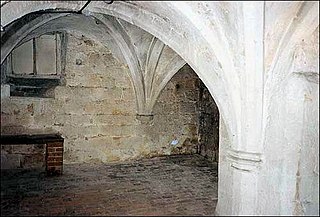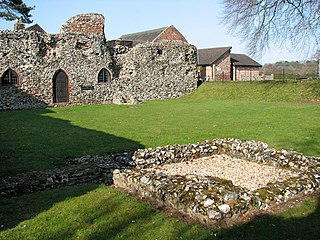
Wymondham Abbey is the Anglican parish church for the town of Wymondham in Norfolk, England.

Walsingham is a civil parish in North Norfolk, England, famous for its religious shrines in honour of Mary, mother of Jesus. It also contains the ruins of two medieval monastic houses. Walsingham is 27 miles northwest of Norwich.

Spinney Abbey, originally known as Spinney Priory, is a house and farm on the site of a former monastic foundation close to the village of Wicken, on the edge of the fens in Cambridgeshire, England.

Bourne Abbey and the Parish Church of St. Peter and St. Paul is a scheduled Grade I church in Bourne, Lincolnshire, England. The building remains in parochial use, despite the 16th-century Dissolution, as the nave was used by the parish, probably from the time of the foundation of the abbey in 1138.

Thetford Priory is a Cluniac monastic house in Thetford, Norfolk, England. Founded in 1103 by Roger Bigod of Norfolk, Thetford was one of the most important monasteries of East Anglia.

Old Buckenham Castle and Buckenham Castle are two castles adjacent respectively to the villages of Old Buckenham and New Buckenham, Norfolk, England.

The remains of St Mary's Abbey, of Kenilworth, Warwickshire, England are situated in the grounds of St Nicholas' Church and in an adjacent area of Abbey Fields. Some of its ruins are above ground and some are below ground.

Pentney is a village and civil parish in the English county of Norfolk, located about 8 miles (13 km) south east of King's Lynn placing it about halfway between King's Lynn and Swaffham on the A47 road. It covers an area of 10.39 km2 (4.01 sq mi) and had a population of 387 in 184 households at the 2001 census, increasing to 544 at the 2011 Census. For the purposes of local government, it falls within the district of King's Lynn and West Norfolk. It is in the valley of the River Nar, a tributary of the River Great Ouse.
Marmont Priory was a priory for Gilbertine Canons in Cambridgeshire, England. It was established by landowner Ralph de Hauvill as a small priory or chantry of three canons who prayed for the souls of de Hauvill and his wife, Maud. Fifteen years earlier, Maud had a vision of Gilbert of Sempringham ascending to Heaven on the day of his death.
St Katherine's Priory also known as The Priory of Saint Katherine without Lincoln was a Gilbertine priory of Canons Regular on the Fosse Way just outside the walls of Lincoln, England. The priory ran the Hospital of St Sepulchre, probably the first hospital in the city.

Pentney Priory was an Augustinian priory at Pentney in the district of King's Lynn and West Norfolk, Norfolk, England. The ruins of the priory, mostly comprising the flint-built gatehouse, are Grade I listed.

Holy Sepulchre Church was a medieval monastic house in Thetford, Norfolk. The ruined nave of this 14th-century church are the only surviving remains in England of a priory of Canons of the Holy Sepulchre, who followed the Rule of Saint Augustine and aided pilgrims to Christ's tomb. It was later used as a barn, and is a Grade I listed building.
Blackfriars, Thetford was a priory in Norfolk, England, which belonged to the Dominican Order. It was one of several religious houses in Thetford closed at the time of the Dissolution of the Monasteries. The site is now occupied by Thetford Grammar School.

Stone Priory was a priory founded at Stone in Staffordshire, England, in about 670 AD. The priory's church was dedicated to Saint Mary and Saint Wulfad, a local seventh-century martyr and supposedly a son of King Wulfhere of Mercia, who ruled from 658 until his death in 675. The mid-15th century Rimed Chronicle of Stone Priory, found at the Priory at the Dissolution of the Monasteries, records the founding legend and the names of the Stafford family patrons up to 1403, and the places of their burials.

Blythburgh Priory was a medieval monastic house of Augustinian canons, dedicated to the Blessed Virgin Mary, located in the village of Blythburgh in Suffolk, England. Founded in the early 12th century, it was among the first Augustinian houses in England and began as a cell of St Osyth's Priory in Essex. Although it acquired a conventual life of its own, its community was always small and in some respects maintained dependency upon the parent house. It was earmarked for closure by Cardinal Wolsey during the late 1520s but survived his fall and continued until dissolution in 1536.
Campsey Priory was a religious house of Augustinian canonesses at Campsea Ashe, Suffolk, about 1.5 miles (2.5 km) southeast of Wickham Market. It was founded shortly before 1195 on behalf of two of his sisters by Theobald de Valoines, who, with his wife Avice, had previously founded Hickling Priory in Norfolk for male canons in 1185. Both houses were suppressed in 1536.
Snape Priory was a priory in Suffolk, England. It was founded as a cell of the Benedictine St John's Abbey, Colchester in Essex.

Herringfleet Priory was an Augustinian priory of Black Canons located in St Olaves, 6 miles (9.7 km) north-west of Lowestoft in eastern England. The site is in the county of Norfolk, although prior to 1974 it was part of the former Suffolk parish of Herringfleet. Founded in 1239, the priory was situated near the ancient ferry across the River Waveney. The priory of SS. Mary and Olave was founded by Sir Roger Fitz Osbert of Somerley in the time of Henry III. The remains consist of the undercroft, two aisles of the Lady Chapel, and the refectory, now a barn.
William d'Aubigny, sometimes William de Albini, was an Anglo-French baron and administrator who served successive kings of England and acquired large estates in Norfolk. From his title of Butler to King Henry I of England, he was called William d'Aubigny Pincerna to distinguish him from other men of the same name.













